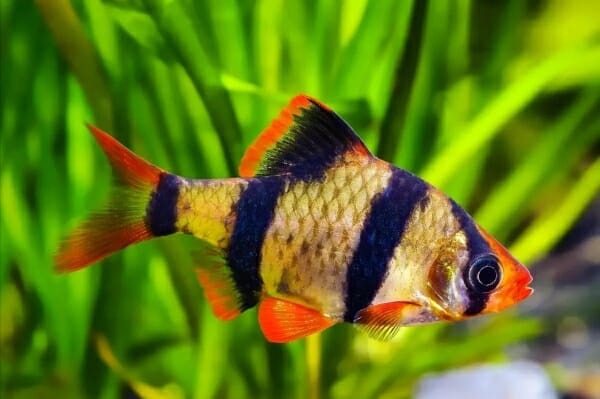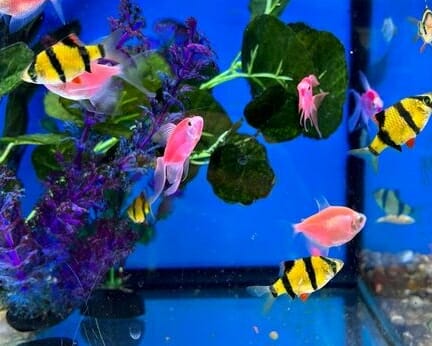Tiger Barb Swimming Upside Down: Reasons and Treatment

Your tiger barb fish may swim upside down because they are scared or feel threatened. In addition, some fish swim bizarrely when they try to communicate with other fish. However, if the swimming is persistent and occurs with other fish, it may indicate a health issue. If you notice that your tiger barb fish swims unusually or erratically, please consult with a veterinarian.
Table of Contents
Possible Reasons Why Tiger Barbs Swim Upside Down
Poor Tank Aeration
If your tiger barb fish is swimming upside down, it may be due to an issue with tank aeration. Poor air circulation can cause various problems in an aquarium, including increased CO2 and decreased oxygen levels.
Poor tank aeration can be a problem for many fish, but it is especially troublesome for tiger barbs. These fish are very active underwater and need plenty of oxygen to survive. If the tank isn’t sufficiently aerated, the water will become stagnant and challenging for your tiger barb to breathe. As a result, these fish may develop respiratory problems or even die.
To test whether your tank is aerated correctly, use an ammonia test kit or take several measurements of Carbon Dioxide (CO2) levels with a datalogger. If you notice any significant improvements after installing new tanks, filters, or bubblers, your tank may need further aeration work.
Compromised Water Quality in the Tank
Swimming upside down may also indicate compromised water quality in the tank. This can be caused by poor filtration or faulty drainage systems. For example, suppose you notice that your fish are swimming unusually or erratically, and the water appears to have a sour smell or has visible fecal matter. In that case, you should address the problem as soon as possible.
A qualified aquarist can test your water and recommend corrective measures if necessary. In addition, if you see any white patches on your tiger barb fish, or if it starts to lose its appetite or combativeness, these may indicate compromised water quality. If this is the case, please consult with a veterinarian for further diagnosis and treatment.
Health Conditions That Affect Your Tiger Barb
Poor tank aeration, water quality, or nutrition can all cause swimming inverts to behave unusually or erratically. However, other health conditions affecting your fish include infections (mainly bacteria), parasites, and disease.
If you notice any change in behavior or appearance of your tiger barb fish and you cannot seem to identify the source of the issue, please consult a qualified veterinarian for further guidance. In addition, be sure to keep an eye on water quality and adjust your tank parameters as needed.
Improper Water Temperatures in the Tank
Tiger barbs are tropical fish and, as a result, prefer warm water temperatures. If your tank isn’t getting the temperature it needs, your fish may start to swim erratically or unusually. To test tank temperature levels:
1) Fill a glass with lukewarm tap water and set it next to your aquarium;
2) Watch how long it takes for the glass filled with room-temperature water to reach the same level as the glass filled with cold tap water. This will confirm that your aquarium is receiving enough heat.
If your tank isn’t getting the temperature it needs, you can try one of these tips to increase the warmth in your tank:
1) Add a ceramic heater;
2) Increase the number of live plants in your aquarium; or
3) Heat water from a cold tap using a hand warmer.

How Do Tiger Barbs Learn Swimming Upside Down?
Your tiger barb fish may associate learning unusual or erratic swimming with environmental stimuli. This could include changes in water temperature, pH levels, or light intensity.
If you want to reintroduce your fish to its original habitat, gradually introducing these environmental stimuli over several days may help.
How Can I Treat a Tiger Barb That Is Swimming Upside Down?
If your tiger barb is swimming unusually or erratically and you can’t identify the source of the issue, it may be helpful to consult a veterinarian. In addition, make sure to keep an eye on water quality and adjust your tank parameters as needed. Here are the best practices you can do to prevent abnormal swimming among your tiger barbs:
Large Tanks Work Best
Tiger barb fish prefer large, open tanks with plenty of swimming room. They are not as content living in smaller aquariums and may become stressed or agitated if confined to a small space. In addition, they are less active when housed in a smaller tank and may not consume enough food.
Choose the Right Tank Mates
Tiger barb fish are sensitive to environmental changes and should only be kept with compatible tank mates that will not stress or injure them. They prefer peaceful fish species that can live harmoniously in an active aquarium. This includes rosy barb, cherry barb, cory catfish, and most types of plecos.
Avoid including dangerous and semi-dangerous fish species as these could potentially attack your tiger barbs. In addition, avoid keeping these fish with other types of exotic ornamental fishes as they may compete for food and territory.
Give Proper Aquarium Conditions
A tiger barb fish is a hardy fish that can handle moderate to high levels of aquarium pH and water hardness. However, they do best when maintained at 77 – 82 °F. Keep your tank clean and decorated with live plants for height and visual interest.
Feed your tiger barb small meals several times daily supplemented with fresh aquatic vegetation or specialty food pellets. Additionally, please provide them with an appropriate hiding place and plenty of swimming room.
Create a Conducive Tank Environment
Create a tank that is as conducive as possible for your tiger barb fish. They thrive in an aquarium with plenty of swimming space, live plants, and water movement. Fill the tank almost to the top with fresh water, allowing room for overflows on all sides.
Submerge your live plants halfway into the water while keeping their roots wetted down throughout the day to help them absorb nutrients from the substrate. In addition, you will create a well-rounded environment that accommodates their needs and desires.
Additionally, it is essential to keep the tank clean and free of debris as this can cause your tiger barb fish to develop intestinal issues.

Should I Quarantine a Tiger Barb That Is Swimming Upside Down?
It is not necessary to quarantine a tiger barb if it is displaying unusual or erratic swimming behavior. However, you may want to keep your fish separate from other fish until the issue has been resolved.